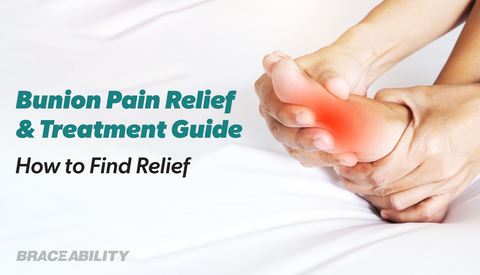The Beginner’s Guide to Juvenile Idiopathic Arthritis
Nothing is worse than seeing your child in pain. When you think of arthritis, you may be thinking it can only occur in adults, but that is far from the case. If your child is dealing with arthritis pain, you are not alone. Keep reading to learn more about juvenile arthritis, including symptoms, diagnosis, and treatment.
What is Juvenile Idiopathic Arthritis?
There are a variety of forms and types of arthritis. Juvenile idiopathic arthritis (JIA), previously known as juvenile rheumatoid arthritis (JRA), occurs in kids and teens under the age of 16, causing joint pain and inflammation in the knees, elbows, ankles, fingers, and/or wrists. This condition is an autoimmune disorder, which means that the immune system malfunctions and attacks the body's organs and tissues, in this case, the joints.

What to Look For: Signs & Symptoms of Childhood Arthritis
The symptoms of juvenile idiopathic arthritis can range based on the case. Some symptoms show up in episodes or flare-ups, while for others the symptoms may be ongoing or chronic. Taking action right away is key to keeping the disease under control, so these signs and symptoms are important to keep an eye out for.
Although they may differ, some of the JIA symptoms may include:
- Joint pain and stiffness
- High fever and rash
- Loss of appetite
- Red and/or swollen joints
- Fatigue
- Blurred vision, or dry eyes
- Less ability to move joints
Talk to your doctor or medical professional if your child is experiencing extreme joint pain, swelling, or stiffness for more than a week, especially if he or she has a consistently high fever.
Different Types of JIA
Juvenile idiopathic arthritis can be broken down into various subtypes, all regarding a slightly different type of arthritis. Although the treatment options will be similar, it is important to know which subtype your child has in order to prevent the condition as best as possible.
There are 6 subtypes of JIA:
- Polyarthritis: Affects 5 or more joints
- Systematic: Affects the entire body
- Psoriatic (PsA): Affects 1 or more joints, and scaly rash
- Oligoarthritis: Affects 4 or fewer joints
- Spondyloarthritis: Affects where muscles, tendons, or ligaments connect to the bone
- Undifferentiated: Symptoms don’t match up perfectly with any of the subtypes
Juvenile Arthritis Diagnosis
Joint pain can be caused by a variety of things, which is why diagnosing juvenile idiopathic arthritis can be tricky. As of now, there is not a single test that can diagnose JIA, but there are multiple other tests that can rule out other conditions which have the same signs and symptoms. The two main ways to diagnose juvenile arthritis are through blood work tests and imaging scans (x-rays or MRIs).
Can Arthritis in Kids & Teens Be Treated?
While there is no certain cure for JIA, there are many treatment methods to keep your child pain-free and help them live out a normal childhood.
The 3 categories of juvenile idiopathic arthritis treatment include:
- Therapy & Bracing
A great way to improve joint and muscle function and strength is through physical therapy. Occupational therapy has also proven itself to be helpful to improve the ability to perform daily activities. You should also consider the use of a supportive arthritis brace to help reduce pain, swelling, and discomfort while your child is active, especially during school, sports, or any activity that requires the joints to be heavily used. Check out our line of pediatric braces for kids to find what will work best for your child.
- Medication
Various medications could work for the treatment of JIA, depending on the severity of the case. Most commonly non-steroidal anti-inflammatory medicines will be prescribed to your child in order to reduce pain and inflammation.
- Surgery
For the most severe cases of JIA, surgery may be necessary. Joint replacement surgery won’t be needed for most children, but it is available for the most advanced cases that were not caught early on.
There are also some at-home lifestyle changes you can make to help treat JIA. These include regular daily exercise, cold packs, or hot baths to soothe sore joints and a healthy diet.
Risk Factors & Complications From Untreated Juvenile Arthritis
When it comes to JIA, it’s crucial you stay on top of treating symptoms. Your child’s body is going to change drastically as they grow and overlooking their arthritis can cause major damage.
There are a variety of health effects that may be caused by untreated juvenile arthritis, such as:
- Eye pain, redness, and dryness
- Damage to the heart muscle
- Difficulty chewing, flossing, or brushing teeth
- Foot pain and difficulty walking
- Potential growth delay
- Skin rash
- Late-onset of puberty
Assure you are up to date on your child’s symptoms and stick with consistent treatment methods in order to prevent these health effects from occurring.
Coping With JIA: You’re Not Alone
While dealing with the aches and pains that come along with arthritis, know that you are not alone. Juvenile arthritis can be difficult to deal with, especially for an active child, but taking the right action will make a huge difference for your child and the pain they are feeling.
Keep in mind that children and teens with JIA are more likely to get depressed, due to living with this painful, chronic disease. Having a strong support system of friends and family can provide emotional support during tough times.
Shop Products From This Article












